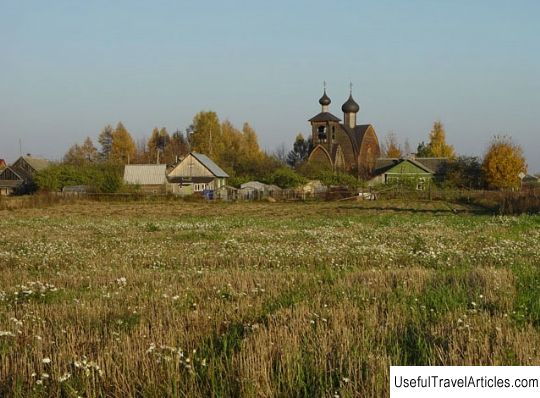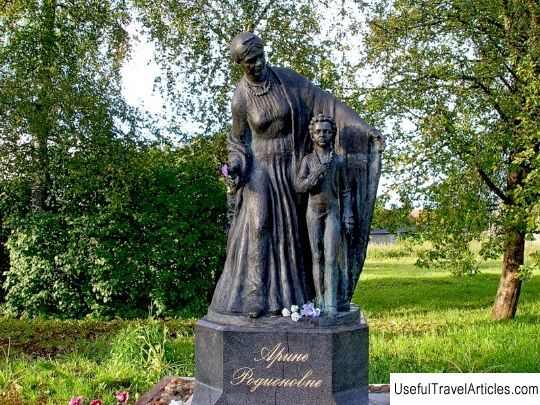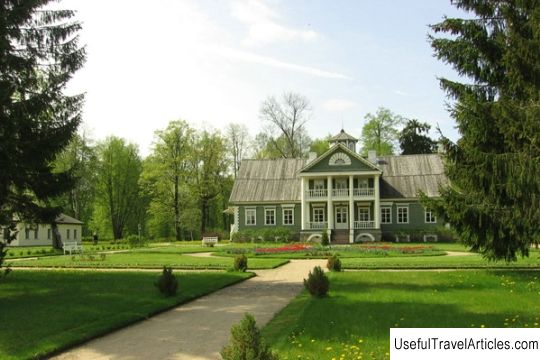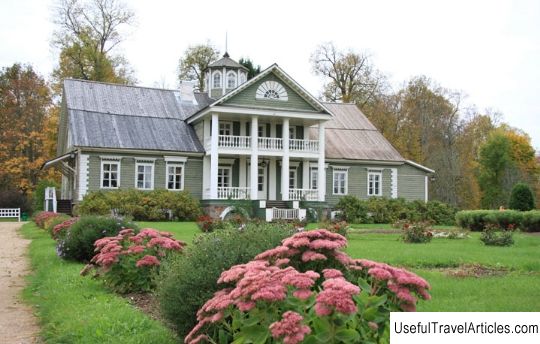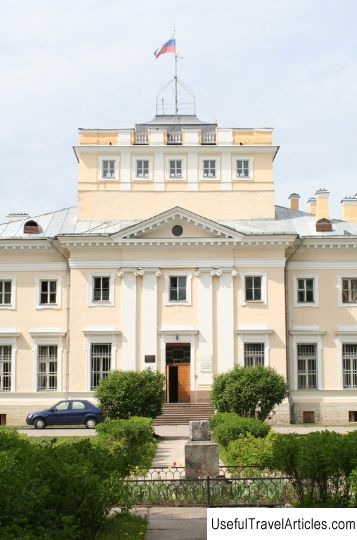Museum-estate ”Suida” description and photo - Russia - Leningrad region: Gatchinsky district
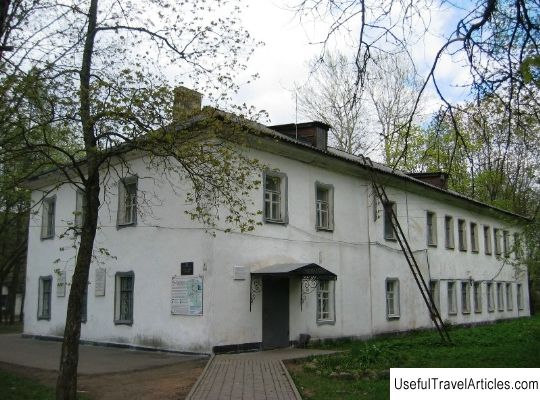
Museum-estate "Suida" description and photo - Russia - Leningrad region: Gatchinsky district. Detailed information about the attraction. Description, photos and a map showing the nearest significant objects. Photo and descriptionMuseum-estate "Suida" - the former estate of the great-grandfather of the great Russian poet A.S. Pushkin, Hannibal Abram Petrovich. The mysterious personality of Peter I's associate still haunts many historians. In the spring of 1759, A.P. Hannibal acquired the Suida estate with the village of Voskresenskoye and the surrounding villages from Count Fedor Alekseevich Apraksin. Here Hannibal set up the main estate of his possessions, later to which he bought the neighboring Yelitsk, Kobrin and Taitsk lands. In Suida A.P. Hannibal settled with his family in 1762 after retirement. In Suida there was already a Baroque manor house, services, a regular garden with a pond, and other manor buildings. Abram Petrovich attached great importance to the improvement of his estate. Under him, channels were created here, new alleys appeared, a humpbacked bridge, a gazebo, a grotto were erected. A stone mill was built near the road to Kobrino, on the Suyda River. They say that there was even a fountain, a sundial in the Hannibal estate. But the main attraction of Suida was a stone sofa, which was carved into a huge boulder by the serfs. At the time of Hannibal, agriculture in Suida was flourishing. Here they began to grow potatoes, which were then considered a curiosity, the greenhouses, where peaches, lemons, and apricots were grown, were a special pride of the estate. Half of all the area of the estate was arable land. Sustainable harvests were ensured by a special drainage system that diverted water from waterlogged lands. Abram Petrovich was a zealous parishioner in the church in Suida and took care of it: in due time they donated several spiritual books to the temple. Hannibal's house was filled with numerous relics associated with Peter I. The library was the pride of the owner. The manor house burned down in 1897 Hannibal died in Suida in 1781. He was buried in the Old Cemetery, but the grave was later lost. Nowadays, a granite stele has been installed at the supposed place of his burial. According to the will, the patrimony of Hannibal went to his eldest son, Ivan, a famous military leader of Catherine's time, the founder of the city of Kherson, the hero of the Battle of Chesme. Ivan Abramovich spent most of his time in Suida. The famous commander Suvorov was a frequent visitor to the estate. Legends about the "black master" are still circulating on the land of Suida. And some even think that their genealogies contain the blood of the Hannibals. The village of Voskresenskoye, which was part of the Hannibal estate, is associated with the name of the nanny A.S. Pushkin - the well-known Arina Rodionovna. Here she was born, hence her fairy tales. And to this day, the Pestrikovs live here - the descendants of her relatives. In the Suida estate, Nadezhda Hannibal, the mother of the great poet, was born, spent her childhood and grew up. Here in 1796 she married Lieutenant S.L. Pushkin. They lived on this estate after the wedding. It is not known whether Alexander Sergeevich has been here. According to legend, it is here that the famous Pushkin Lukomorye is located, and quite recently a seven-hundred-year-old oak rose in the manor park on the bank of the pond. Now there is a museum in Suida. It was created in 1986 as a public, but received state status in the year of the 200th anniversary of the poet's birth. The museum occupies a part of the original stone building from the time of Hannibal - the guest wing. The main exposition of the museum is represented by memorial relics of Abram Petrovich and his descendants. Here are items from Pushkin's great-grandfather: a bronze candlestick, books from his library, a box, a silver teaspoon, a snuffbox. Most of the exhibits were donated to the museum by Hannibal's Moscow and St. Petersburg descendants, Suida's old-timers, and Pushkin scholars. The pride of the museum is an old towel with lace and the monogram "AS" They say that it belonged to A.S. Pushkin. In addition to the Hannibal wing, Suida has preserved: stables, a steward's house, a man's house, a barnyard, a smithy. The original decoration of the estate is the old park, in which part of the Kupalnaya Linden Alley survived. The Linden, Birch and Spruce alleys have been partially preserved. In 1990, during the laying of a gas pipeline through the center of the estate, the foundations of an old house and numerous relics of the past were discovered. Among the finds are of particular value: clay smoking pipes, fragments of Dutch stove tiles, a copper coin of 1766, fragments of porcelain and glassware, a cannonball, a copper travel bell, forged nails. At present, all these relics have been transferred to the exposition of the Suyda Museum. Pushkin's festivals are held annually in the Suida Estate Museum, and descendants of the Hannibals often come here. The Linden, Birch and Spruce alleys have been partially preserved.Hannibal's stone sofa, which used to be on the Wet Meadow, now stands in front of the pond. In 1990, during the laying of a gas pipeline through the center of the estate, the foundations of an old house and numerous relics of the past were discovered. Among the finds are of particular value: clay smoking pipes, fragments of Dutch stove tiles, a copper coin of 1766, fragments of porcelain and glassware, a cannonball, a copper travel bell, forged nails. Currently, all these relics have been transferred to the exposition of the Suyda Museum. Pushkin's festivals are held annually in the Suida Museum-Estate, and descendants of the Hannibals often come here. Linden, Berezovye and Spruce alleys have been partially preserved.Hannibal's stone sofa, which used to be on the Wet Meadow, now stands in front of the pond. In 1990, during the laying of a gas pipeline through the center of the estate, the foundations of an old house and numerous relics of the past were discovered. Among the finds are of particular value: clay smoking pipes, fragments of Dutch stove tiles, a copper coin of 1766, fragments of porcelain and glassware, a cannonball, a copper travel bell, forged nails. Currently, all these relics have been transferred to the exposition of the Suyda Museum. Pushkin's festivals are held annually in the Suida Museum-Estate, and descendants of the Hannibals often come here. which used to be on Mokroye Meadow, now stands in front of a pond.In 1990, during the laying of a gas pipeline through the center of the estate, the foundations of an old house and numerous relics of the past were discovered. Among the finds are of particular value: clay smoking pipes, fragments of Dutch stove tiles, a copper coin of 1766, fragments of porcelain and glassware, a cannonball, a copper travel bell, forged nails. Currently, all these relics have been transferred to the exposition of the Suyda Museum. Pushkin's festivals are held annually in the Suida Museum-Estate, and descendants of the Hannibals often come here. which used to be on Mokroye Meadow, now stands in front of a pond.In 1990, during the laying of a gas pipeline through the center of the estate, the foundations of an old house and numerous relics of the past were discovered. Among the finds are of particular value: clay smoking pipes, fragments of Dutch stove tiles, a copper coin of 1766, fragments of porcelain and glassware, a cannonball, a copper travel bell, forged nails. At present, all these relics have been transferred to the exposition of the Suyda Museum. Pushkin's festivals are held annually in the Suida Estate Museum, and descendants of the Hannibals often come here. the foundations of an old house and numerous relics of the past were discovered. Among the finds are of particular value: clay smoking pipes, fragments of Dutch stove tiles, a copper coin of 1766, fragments of porcelain and glassware, a cannonball, a copper travel bell, forged nails. Currently, all these relics have been transferred to the exposition of the Suyda Museum.Pushkin's festivals are held annually in the Suida Museum-Estate, and descendants of the Hannibals often come here. the foundations of an old house and numerous relics of the past were discovered. Among the finds are of particular value: clay smoking pipes, fragments of Dutch stove tiles, a copper coin of 1766, fragments of porcelain and glassware, a cannonball, a copper travel bell, forged nails. Currently, all these relics have been transferred to the exposition of the Suyda Museum.Pushkin's festivals are held annually in the Suida Museum-Estate, and descendants of the Hannibals often come here.         We also recommend reading Changgyeonggung Palace description and photos - South Korea: Seoul Topic: Museum-estate ”Suida” description and photo - Russia - Leningrad region: Gatchinsky district. |
